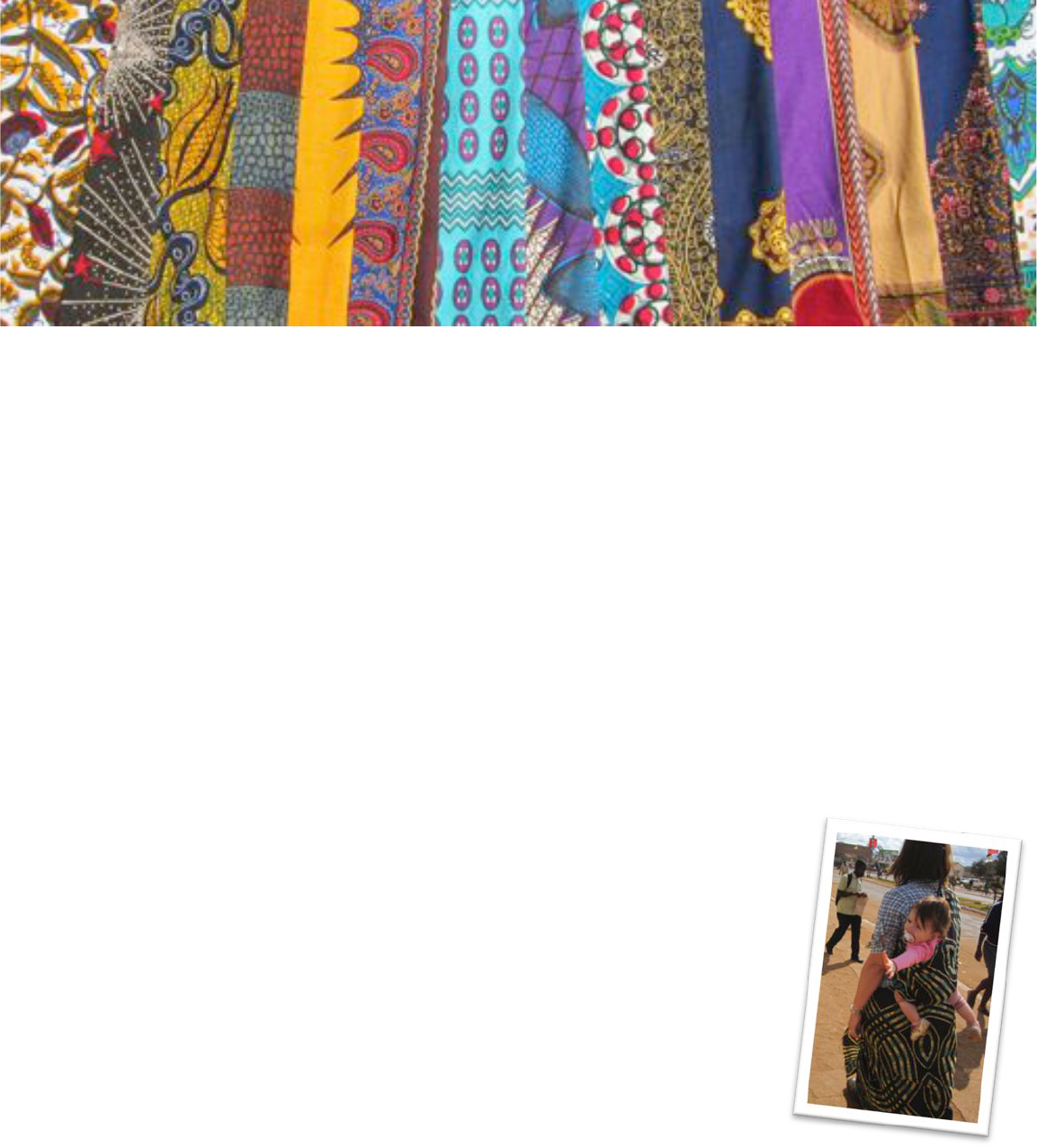
A Beginners Guide to Capulanas
When I first arrived here in Mozambique I didn’t even know how to say capulana. I must have asked Heather at
least 10 times – “What are they called again?” and I just couldn’t figure out why on earth people had them all the
time. Just over a year later and I am a true capulana convert. I never go anywhere without one. Even on holidays to
“normal” places like Cape Town, I take at least five and usually use them all! So here’s a little guide for beginners.
Just in case you’re thinking (like I would have last year) “That’s nice of you Kath, but what on earth am I going to
do with this?” Hopefully you’ll see that as well as being authentically African, they’re also very useful.
First things first
When I first arrived here in Lichinga, I figured I should try and fit in so I headed to the
markets to get myself some capulanas. I figured it would be pretty straightforward but
ended up with some fairly ugly, poor quality, fraying bits of material that I think my
language helper was embarrassed by. Judging by that picture, I think even Sydney
knew they just weren’t right. After some not so subtle hints “You need to buy stronger
capulanas! You should get them hemmed!” I soon changed my ways.
Capulana shopping can be quite overwhelming for a newbie. There are so many to
choose from for a start. It’s confusing when you don’t understand the lengths that they
come in. Then when you do finally figure out that you only want one, not two – it can
be downright scary when the man who doesn’t speak the same language as you gets
out the big rusty knife / scissors and asks you to hold the other end as it cuts towards
you. Then to top it off – he runs away with your money!
So some good things to know are… if you see something you like, buy it. It’s hard to find again next time and it
might just not be there. One capulana is approximately 2m long. Often they have 2 hanging together (4m of
material), if you only want one, they’ll either cut it, or find one for you that is already cut. If you want two, it’s good
to let them know if you want it cut or not. I haven’t been cut yet – these guys are pretty handy with sharp
instruments so just close your eyes and look away, she’ll be right. He’s not stealing your money – he’s just off to
find someone who has some change. He will come back. I promise. At the moment, the better quality capulanas
are 170Mets (about $6), the thinner ones 100 Mets.
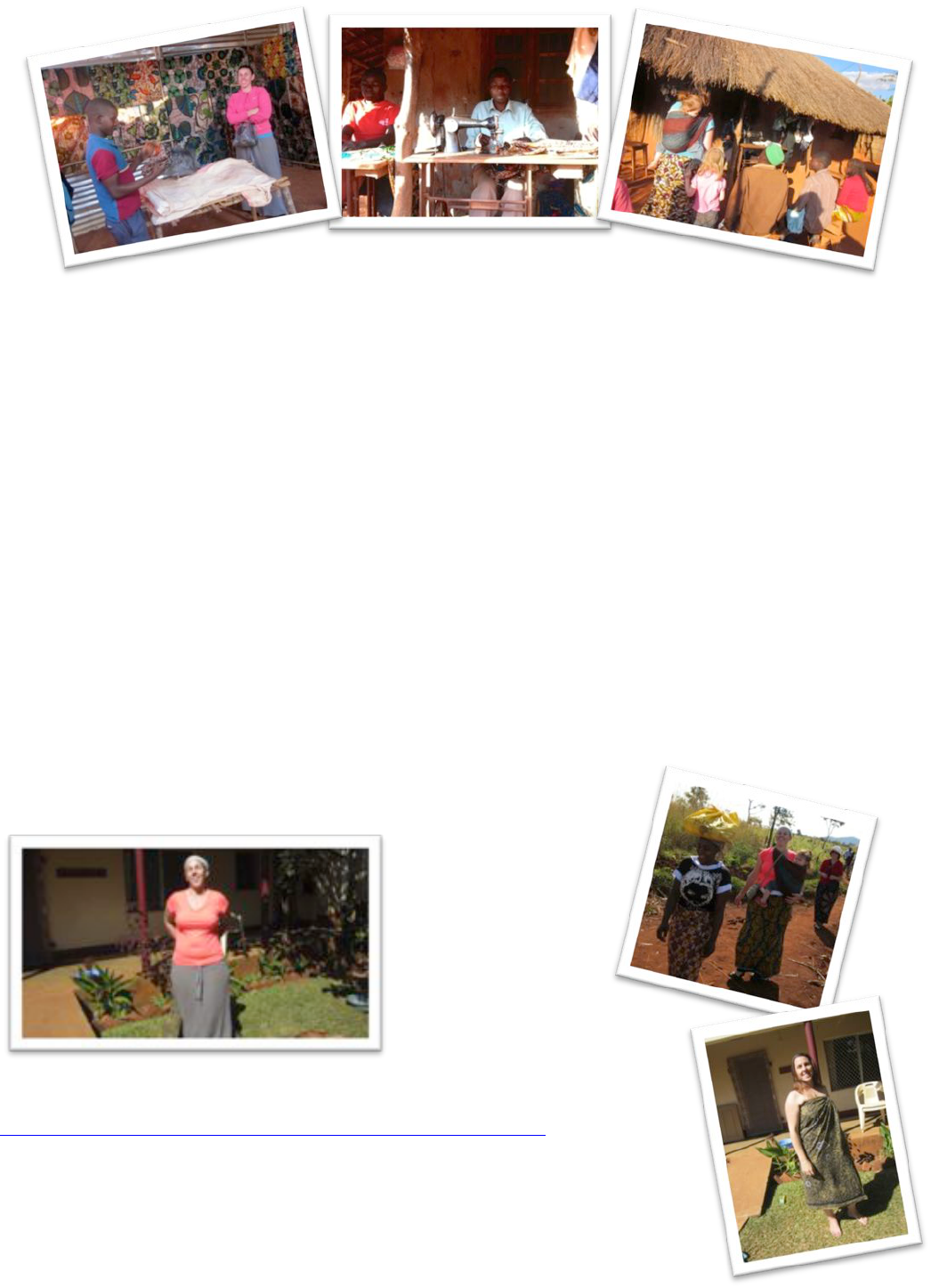
Some of the capulanas have paper stickers on them. They’re such a pain to get off it’s much better if you can just
avoid them altogether. But if you do happen to have one with a sticker – soak it in some warm water, peel, scrub,
peel, scrub – it will come off eventually. After purchasing your capulana, it’s a great idea to get it hemmed (before
washing). Otherwise they fray and start looking a bit ratty. There are tailors all through the market but I always go
to the guy up the road from me. It costs 10 Mets each capulana (about 30 cents). I often just drop them off one
day and come back the next to pick them up.
What now?
So now that you’ve got your capulana… what do you do with it? The possibilities are really only limited by your
imagination. Here are just a few of the ways in which I have used mine. These are all tried and tested in the field.
There are a few others I have thought of but not yet tried out – perhaps one day I will expand the list.
Instructions for Capulana wearing
Wrap around: Simply wrap around your waist like a sarong. They can be tied for extra security but here they’re
usually an extra layer over pants or a skirt. They’re great for protecting your clothes underneath or just looking
nice. Some women will wear a couple even – that way when you take
the top one off to carry the baby, you’re still all good to go.
Click on this link for the “How to wear it” demonstration video…
https://dl.dropboxusercontent.com/u/72783519/Wearing%20a%20capulana.m4v
Nudey runs: You can basically use them as a towel, as you would a normal bath
towel. Just wrap around above your boobs and tuck in. Great for visits to the
local pool, caravan parks – any place where you’re showering in public. Or for
those times when you remember your only clean bra is still hanging on the
washing line. This style is often employed when washing dishes / clothes or
when a woman is pregnant. It keeps you nice and clean and covers up your
bump.
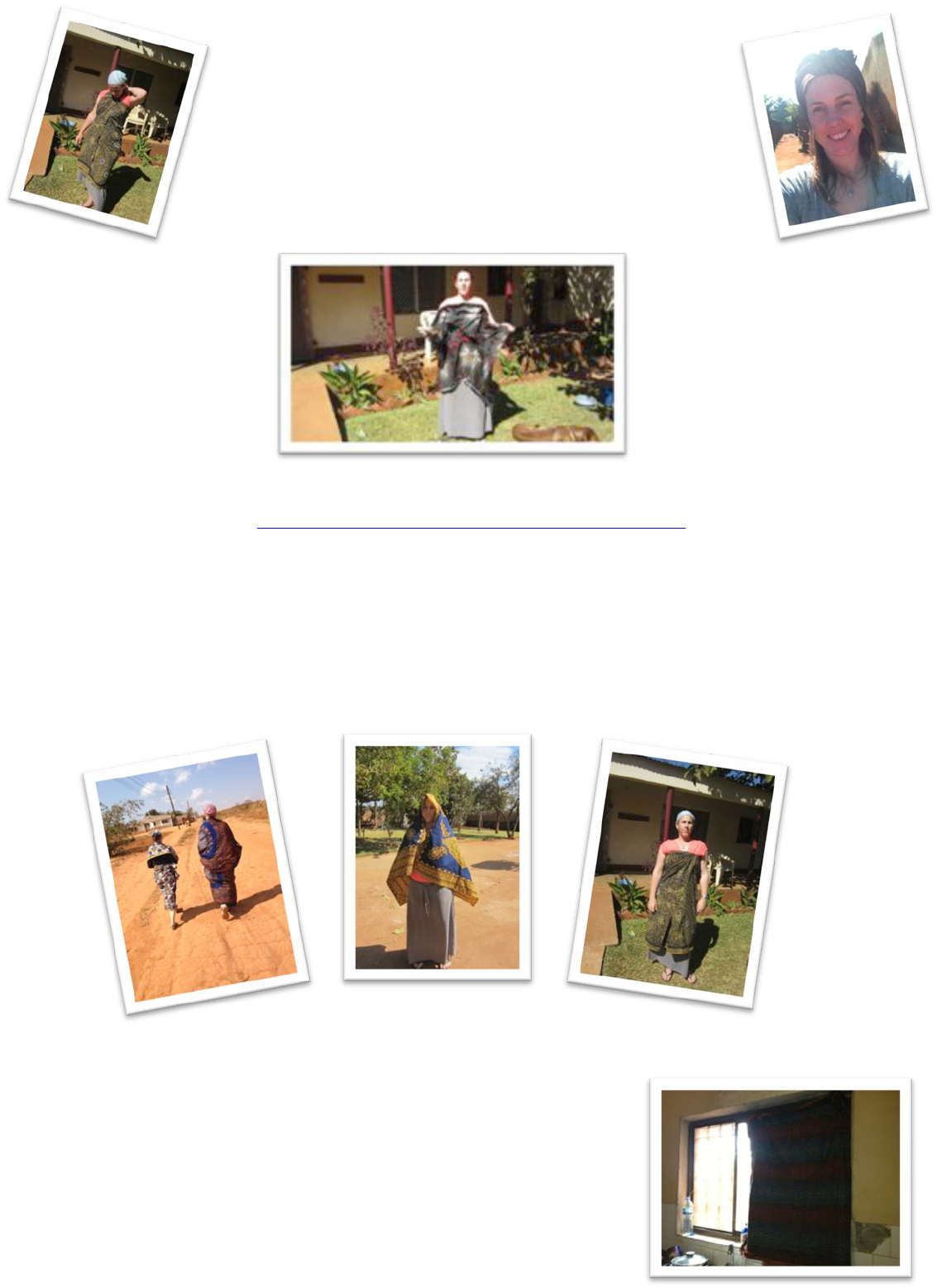
A dress: Admittedly, this works a lot better on people who
aren’t 5’10’’ and carrying a bit too much weight. Just wrap the
capulana across at the front, make a halter neck and tie. Great
beach wear!
Head scarf: I don’t think this looks anywhere near as good on
me as any of the Mozambican women but it’s good to know
how to do it. See the instructional video! Great for funerals and
celebration days.
Click on this link for the “How to turn it into a head covering” video…
https://dl.dropboxusercontent.com/u/72783519/Head%20Scarf.m4v
Sun protection: Simply remove the capulana from around your waist and drape over the exposed part of your
body. This is particularly useful when you find yourself unexpectedly visiting in the middle of the day, in the blazing
sun without your sunscreen. But equally effective on those long summers drives, when just of your arms is getting
sunburnt.
Funerals: Often to funerals here, people will wear a matching set – one on the bottom and then one wrapped
around their shoulders too. I would not recommend doing this in Australia – you’d just look weird.
Around the House
Temporary Curtains: We had some new windows put in a while ago and
didn’t have curtains to put back up in a lot of the places so we just hung
capulanas in the windows. Definitely not a long-term solution but they’re
great for the short term, or maybe in summer if the room’s too hot – just
whack it behind the existing curtain.

Carry all: Washing basket broke? Use a capulana.
Want to carry two boxed cakes to the other side of
town and don’t have a basket big enough? Use a
capulana. Didn’t take a dirty washing bag away with
you? Use a capulana. Endless possibilities! Extra
points if you can carry the package on your head. I
am useless at it!
Table Cloth: Some of them work really well as
tablecloths, like proper nice ones you would use in
your house. And, they have special occasion
capulanas – Merry Christmas! They’re great to use to
decorate.
Travel Needs
Picnic rug: Super lightweight and easy to carry around. Just throw it
down on the floor and you’re good to go.
Picnic table cloth: As opposed to an inside table cloth for decoration
purposes – great for when you rock up at Heathcote and the lazy
people who were at the table before you didn’t clean it down, just
cover it all up with a capulana.
Car shade: So much better than those super expensive ones that fade
and rip after a few months! Just wind down the window a bit (this
works better if you have electric windows that the driver can control)
– poke the end of the capulana through and quickly shut the window
before the whole thing flies out.
iPad holder: I kid you not. One trip, in a desperate bid to stop the
incessant fighting from the back seat (I can’t see! Jack, hold it near
me! Etc etc) I devised this… a $6 iPad car bracket that doubles as a
towel.
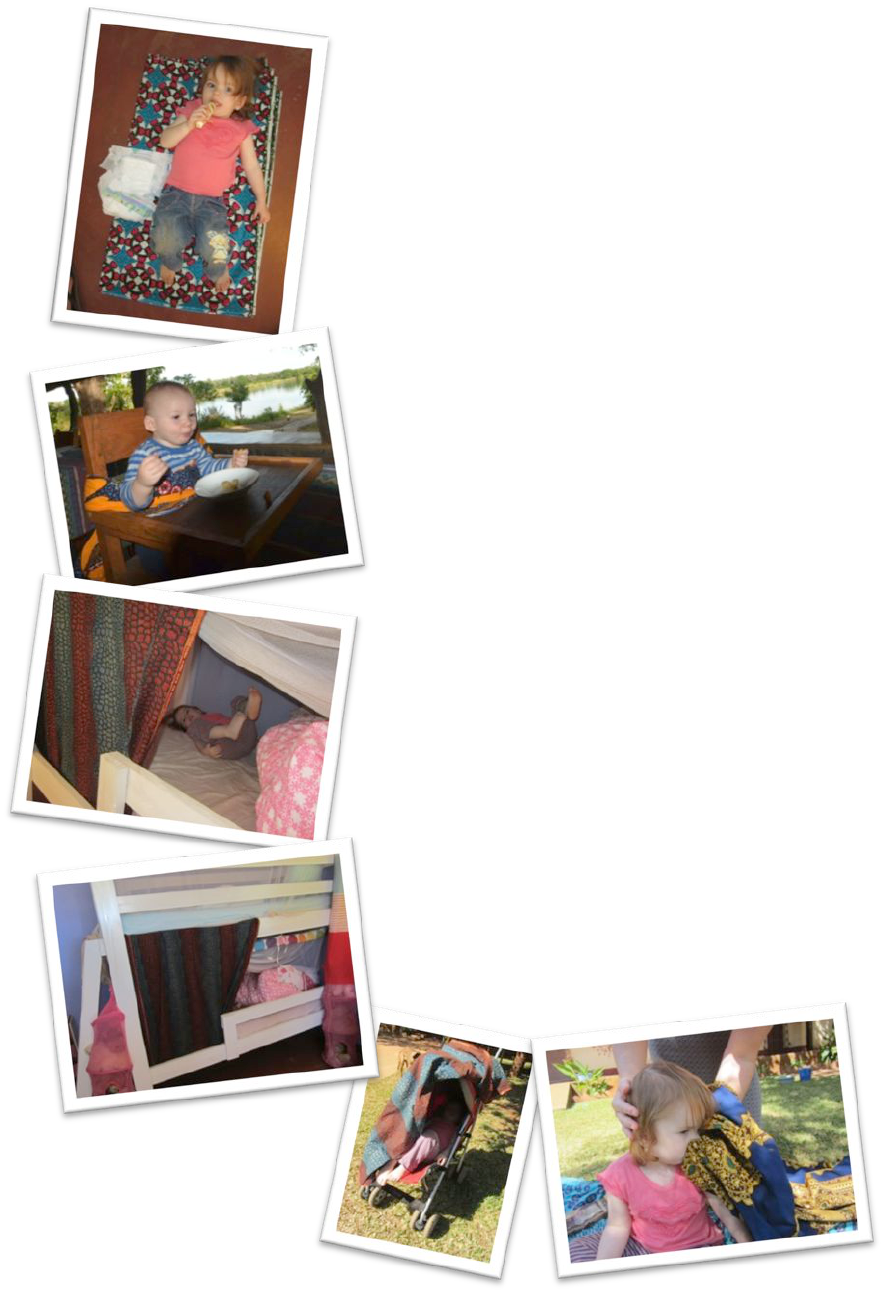
Baby Needs
Cot sheet: Liz was so impressed at my suggestion to use a capulana as a
cot sheet in the Kinder Kot while we were away. It’s the perfect size for that
or a normal cot or a portacot. It’s super easy to wash and takes no time to
dry. Perfect for travelling.
Change mat: Just fold into quarters – place it down on that scabby airport
bathroom floor, oh hang on, scabby Stockland baby change table and
Bob’s your uncle.
High chair seat belt: Child safety is not really that high on the list of priorities
for tourism operators here in Africa it seems. Most of the time it’s just
amazing if people have even considered the needs of children and have
high chairs available. They don’t usually come with restraints though. But
no worries – just bunch up your capulana, secure over baby’s hips and tie
at the back of the chair.
Bunk Bed Guard Rail: Syd’s been in a big girl’s bed for a while now but she
roams around so much at night, she really needs a rail. A few times when
we’ve been away with bunk beds, we put her in the bottom, stretch a
capulana under the top to under the bottom mattress and she’s safe and
sound for the night. Not to mention it keeps things a bit darker and helps her
sleep.
Pram shade / privacy: Takes up no space in the bottom of the pram, when
you’re not using it as a change mat / spew rug – throw it over the top to
keep the sun out or stop all those well meaning people peering in waking up
your almost asleep baby.
Spew Rug: Being so easy to wash and a little bit absorbent, it’s great for
cleaning up accidents or just wiping boogies. Quite a few people have wiped
my child’s nose with their capulana now – it must be love.
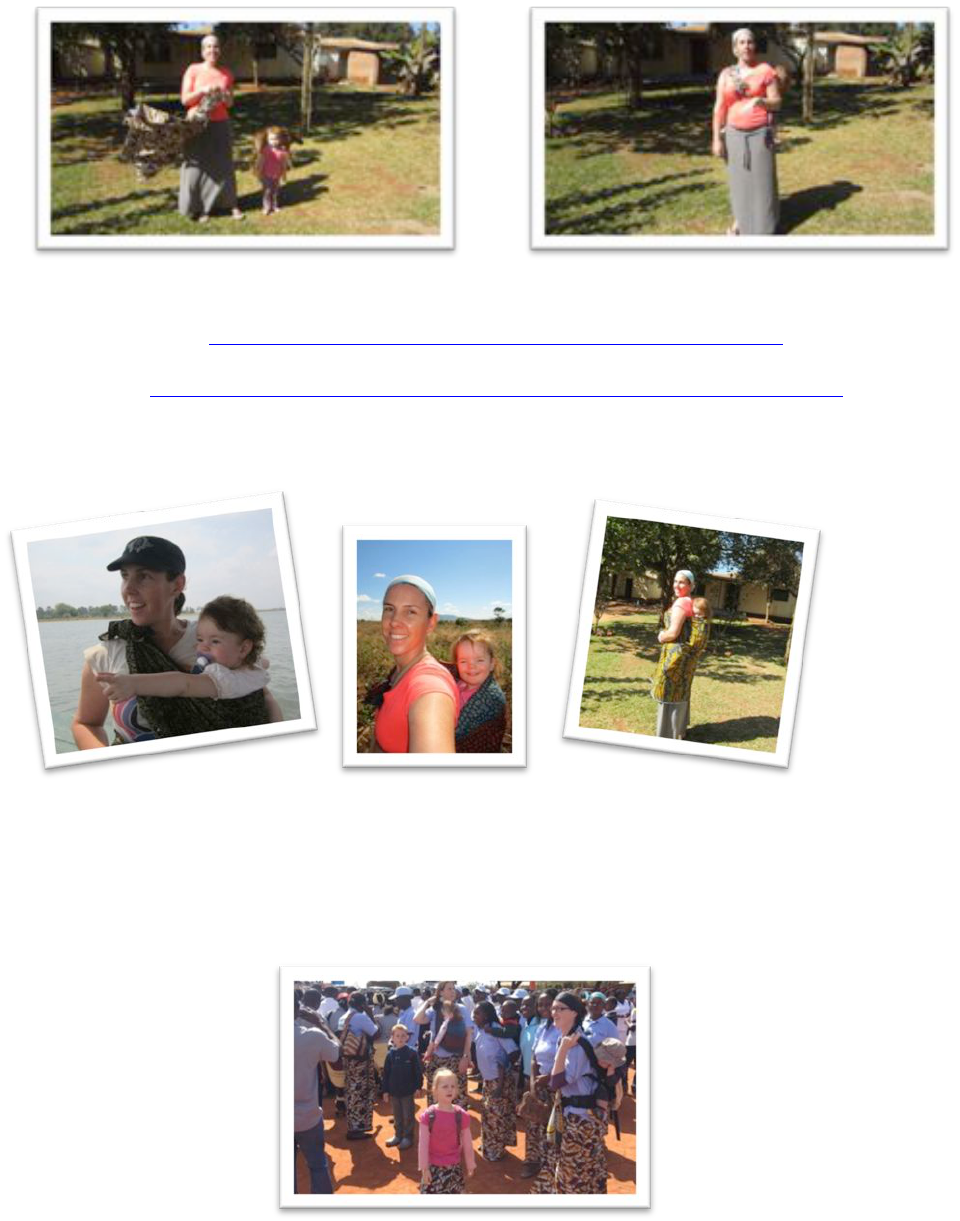
Baby Wearing
In the cupboard in Jack’s room I have a Ring Sling and an Ergo Baby Carrier. The Ring Sling was ok but the Ergo –
I loved it! Was super, super comfortable! But I NEVER use them anymore. The extra comfort just can’t outweigh
the benefits of the capulana. It’s just so small, if Syd’s not in it I just wrap it around my waist, I can use it for a
bazillion other things as well whereas the Ergo – if it’s not carrying a baby… it’s kind of good for nothing.
Anyway – this is a bit too hard to explain how to do – best to watch the video.
Click the first link for the “How to put your baby in a capulana” demonstration video…
https://dl.dropboxusercontent.com/u/72783519/Baby%20Wearing%20.m4v
And the second for the “How to move them from the back to the front” demonstration…
https://dl.dropboxusercontent.com/u/72783519/Move%20baby%20to%20the%20front.m4v
If it’s a particularly cold day, just wrap an extra capulana over the top of your baby. Or you could use a capulana /
Ergo combo – baby in the Ergo, capulana over the top to keep them warm.
Togetherness
The other really great thing that capulanas get used for her is just for a bit of team solidarity and togetherness. For
worker’s day this year, we all wore matching capulanas. Another great thing about them – one size fits all!
